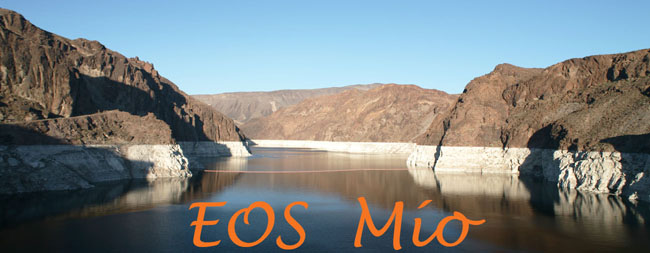Anyway, I learned a few very important digital lessons on this trip, and even had a few lessons I already did know reinforced.
Probably the biggest, painful lesson I learned is that the digital screen on the back of my EOS 5D is quite unreliable in letting me know how an image is exposed. I'll explain. I have the brightness on the screen jacked up so I can see it better. It seemed like a reasonable thing to do, until I got home and looked at the images on our large LCD screen. Oops. Many (but not all) of my images were underexposed. Not a big deal - in most cases I could correct the problem in Photoshop and still get a decent image. I started leaning on my screen more and forgetting a basic rule of photography - trust your meter (in most cases, anyway). Bottom line - the meter is much more reliable than the screen on the back of your DSLR. The screen has its place (composition, are anyone's eyes closed?, etc.), but determining if you have the correct exposure (unless its WAY off) is not one of them, especially if you have the screen's brightness jacked all the way up.
It's now officially time for me to begin using the screen shade I bought a dog's year ago but I'm yet to use.
Anyway, enough talk - on to some images.
 I'll never forget my first trip into Seattle - a mostly clear, crisp, perfect summer day. We rode the car ferry right into downtown Seattle - we docked near the stadiums where the Mariners and Seahawks play. The ferry ride was a quick one, and I didn't have a whole lot of time to take a bunch of different pictures. I only had about 15-20 minutes of time on the upper deck to take pictures. I literally was snapping pictures, hustling around the boat to get all angles.
I'll never forget my first trip into Seattle - a mostly clear, crisp, perfect summer day. We rode the car ferry right into downtown Seattle - we docked near the stadiums where the Mariners and Seahawks play. The ferry ride was a quick one, and I didn't have a whole lot of time to take a bunch of different pictures. I only had about 15-20 minutes of time on the upper deck to take pictures. I literally was snapping pictures, hustling around the boat to get all angles.The above pic is less than stellar. (Insert sarcasm here) I later found out from a tour guide at the Space Needle that Mt. Rainier (know locally simply as "the mountain") is only visible from the Needle about 1/3 of the year; it's often obscured by clouds and fog.
Obviously, on this day, the mountain was visible, but a haze enveloped it. I'm thinking that a ND filter might have done the trick, but I don't have one for either one of my lenses. I don't currently have many filters for my lenses, since I recently changed my line-up to Canon L lenses, I couldn't keep my old filters because of filter size differences. Oh well, I'll get around to that eventually.
Anyway, this pic was a challenge to color-correct in Photoshop, too. I'm still not thrilled with the pic, but as our tour guide said, the mountain can be a challenge to photograph under what passes for the best of conditions. I'll take another run at this mountain next year when we go back.
Canon EOS 5D, Canon 24-70 2.8L lens, ISO 100, circular polarizing filter, exposure unrecorded.
 A closer shot of the Space Needle as we approached on the ferry - much better than the one above. In beginning to wonder if I didn't have the polarizing filter rotated right with the picture above, because this picture is 100 percent better in terms of color balance and white balance, everything. But, I might also beating myself up for nothing - it really was a hazy day, and the shot immediately above was taken when we were much closer to the city.
A closer shot of the Space Needle as we approached on the ferry - much better than the one above. In beginning to wonder if I didn't have the polarizing filter rotated right with the picture above, because this picture is 100 percent better in terms of color balance and white balance, everything. But, I might also beating myself up for nothing - it really was a hazy day, and the shot immediately above was taken when we were much closer to the city.Anyway, I do like this shot - the sky is near perfect in the image on a cloud-free day.
Canon EOS 5D, Canon 70-200 IS 2.8L lens, ISO 100, exposure unrecorded, circular polarizing filter.
 As we were walking in to get in line for the Space Needle, I got down flat on my back and looked up for this shot, taken at 24mm. The polarizing filter really deepened the sky, which I think makes the picture.
As we were walking in to get in line for the Space Needle, I got down flat on my back and looked up for this shot, taken at 24mm. The polarizing filter really deepened the sky, which I think makes the picture.Canon EOS 5D, Canon 24-70 2.8L lens, ISO 100, circular polarizing filter, exposure unrecorded.
 This is one of my favorite shots from our Seattle trip - a city scape from the Space Needle looking out toward Mt. Rainier. To the right, you can see the stadiums the Seahawks and Mariners play in. I didn't have my polarizing filter on for this shot, and I wish I would have.
This is one of my favorite shots from our Seattle trip - a city scape from the Space Needle looking out toward Mt. Rainier. To the right, you can see the stadiums the Seahawks and Mariners play in. I didn't have my polarizing filter on for this shot, and I wish I would have.Canon EOS 5D, Canon 70-200 IS 2.8L lens, ISO 100, exposure unrecorded
 This is another favorite from Seattle - a building with a huge mural of Seattle Mariners center fielder Ichiro Suzuki. The polarizing filter did the trick for this one, taken at 24mm.
This is another favorite from Seattle - a building with a huge mural of Seattle Mariners center fielder Ichiro Suzuki. The polarizing filter did the trick for this one, taken at 24mm.I'm very impressed by the lack of vignetting by Canon's 24-70 f2.8L lens, especially at the minimum focal length. It's the workhorse in my bag that I used for probably 75 percent of my shots, since I take a great deal of landscapes and architecture.
Canon EOS 5D, Canon 24-70 2.8L lens, ISO 100, circular polarizing filter, exposure unrecorded.
Stay tuned - many more photos coming later today / this evening.






No comments:
Post a Comment